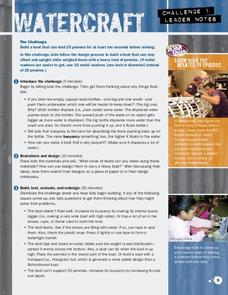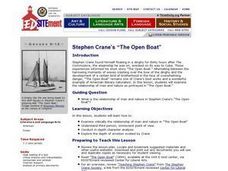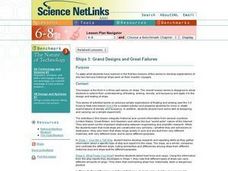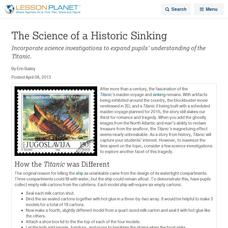Curated OER
What Floats Your Boat?
This open-ended boat building exercise is meant to be part of a three-lesson series on ships. Links to the other two lessons are included. This particular part is mostly a group lab activity in which they build a boat, find its load line...
Curated OER
Ships 2: What Floats Your Boat?
Students design, build, and test the specifications (water displacement and load line) for a model boat. The instructional activity focuses especially on integrating design principles with inquiry-based experimental skills.
Teach Engineering
What Floats Your Boat?
Clay's as good a material as any to build a boat, right? An introductory lesson sets the stage for two activities associated with buoyancy. The first involves building boats out of clay, while the second uses these boats to measure the...
Curated OER
Barge Building: What Floats Your Boat?
Students construct aluminum foil boats that float while holding the greatest number of pennies. They investigate the concept of water displacement, record their results, and watch a Bill Nye video on buoyancy.
Curated OER
What Floats Your Boat?
Learners are introduced to the concept of buoyancy. The Video used in this lesson demonstrates and explains the characteristics of objects that sink and float. It presents the concepts of displacement, weight, and buoyancy.
Curated OER
What Floats Your Boat?
Students explore the principles of buoyancy and Archimedes' Principle and design their own flotation device. They compare the dimensions of a model to the real object to determine scale and analyze the models to suggest improvements.
PBS
Watercraft
Whatever floats your boat—with some additional weight. The first activity in a five-part series challenges pupils to design a boat to hold pennies. Using the design process, learners design, build, and test their boats, making sure they...
Curated OER
Sink or Float?
Have your class explore density and buoyancy using this resource. Learners read the book Who Sank the Boat, and use several items, such as rubber balls, bottle caps, wood, and other household items to conduct an experiment. Using a tub...
Curated OER
Dragon Boats
Students create a model boat. In this art instructional activity, students identify what makes a boat float and use milk cartons to create their own boat.
DiscoverE
Foil Boats
How many pennies can an aluminum foil boat hold? That is the challenge in a collaborative activity designed to explore the concept of buoyancy. Learners use aluminum foil to build makeshift boats and test the weight they hold before...
Curated OER
What Floats Your Boat?
Learners discover the Archimedes principle through a buoyancy experiment. They measure the water displacement of a lump a clay which is denser than water then reshape the clay into a bowl which floats but displaces more water.
Curated OER
Float Your Boat
Students investigate buoyancy, displacement and density. In this flotation lesson plan students study the Archimedes' Principle, analyze data and draw conclusions.
Curated OER
Creating the Ideal Cargo Boat
Students build boats out of clay to test the buoyancy of the boat in water. Students break into pairs and construct their boat to specific guide lines, then experiment with their boat in the water.
Curated OER
Solve a Problem: Build a Boat
Students build a boat that float and hold as many pennies as possible, then discuss the process of building the boat and relate the experience to experiences they encounter in life.
Curated OER
Stephen Crane: The Open Boat
Students explore the genre of American literary naturalism by reading,"The Open Boat" by Stephen Crane. They examine the relationship of man and nature through analysis of the characters, narration and descriptive vocabulary.
DiscoverE
Design a Flotation Device
Save the soup! Scholars devise a flotation device using straws, balloons, foam, corks, and other objects. A can of soup must stay afloat for at least a minute with this device—your dinner might depend on it!
Curated OER
Float the Boat
Students collect data and analyze it using a graph. In this algebra instructional activity, students identify different bodies of water and relate the flowing to math. They collect data on the rate of flow and the height of flow. They...
Curated OER
First To Float
Students determine how to float on their backs in a swimming pool. They participate in swimming lessons at a community pool. While working in small groups they practice floating on their backs to increase their safety around the pools....
Curated OER
Incredible Iceboats
Students explore the concept of floating objects (ice). For this floating lesson, students conduct an investigation in which they hypothesize about the time that an ice boat will last floating in water. Students record their data.
Curated OER
Grand Designs And Great Failures
Young scholars extend their understanding of floating, sinking, density, and buoyancy and apply it to the design and testing of ships. students discover that most ships are constructed very similarly-whether they are schooners or...
Curated OER
Ships 3: Grand Designs And Great Failures
Students engage in this, the third in a three-part series on ships. The overall lesson series is designed to allow students to extend their understanding of floating, sinking, density, and buoyancy and apply it to the design and testing...
Curated OER
Soap Boat
When two vowels go walking, who does the talking? Learners explore this question with several activities featuring words with OA, AI, and EA. The activity includes many fun pictures and requires different skills sets such as context...
Curated OER
The Science of a Historic Sinking
Incorporate science investigations to expand pupils' understanding of the Titanic.
K12 Reader
Change Adjectives into Adverbs
What do you need to turn an adjective into an adverb? Sometimes you need an -ly, but there are other endings. Ask your learners to change the endings of 29 adjectives in order to transform them into adverbs and complete the provided...

























